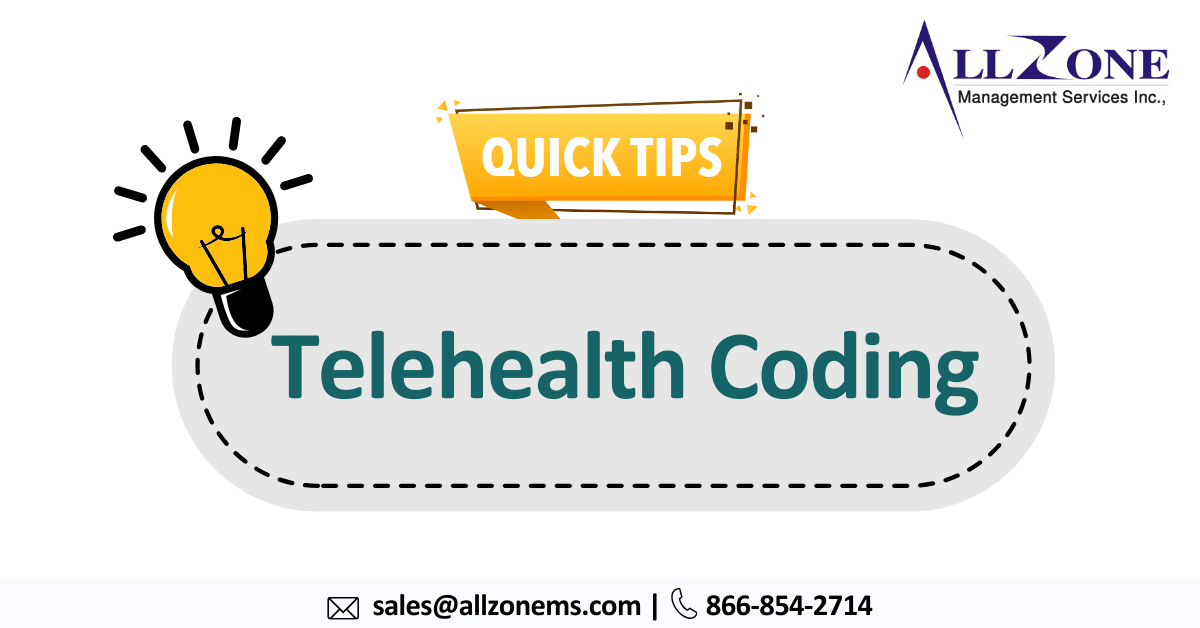Navigating the complexities of telehealth coding is crucial for ensuring that services are properly reimbursed. This guide provides essential information and tips for coding telehealth services accurately, helping physicians avoid denials and recoupments.
1. Telephone Services:
Use Cases:
-
- Suitable for straightforward problems like simple rashes, asymptomatic coughs, and medication refills.
- Requires a minimum of five minutes of medical discussion.
Medicare Codes During PHE:
-
- G2012: Virtual check-in (permanent code)
- 99441-99443: Telephone evaluation and management service by a physician
- 98966-98968: Telephone assessment and management service by a qualified nonphysician healthcare professional
Compliance Tips:
-
- Document verbal consent, including patient acknowledgment and acceptance of any copayments or coinsurance.
- Count only the time spent on medical discussion; do not report calls shorter than five minutes.
- Clearly document the discussion and its outcome (e.g., medications prescribed, referrals).
- Do not report if the call results in a decision to see the patient within 24 hours or if it relates to an E/M service performed in the previous seven days.
- Use codes 99441-99443 and 98966-98968 only for established patients. During the PHE, G2012 can be used for both new and established patients.
Operational Tip:
-
- Implement a manual review process in the practice management system to verify the services’ billability.
2. Telehealth Services:
Eligible Services:
-
- Medicare annual wellness visits
- New and established patient office visits
- Prolonged services
- Smoking and tobacco cessation counseling
- Annual depression and alcohol screenings
- Advanced care planning
- More than 200 other services covered temporarily during PHE
Compliance Tips:
-
- Distinguish between audio-only and audio-visual requirements. For example, audio-visual is required for new patient visits.
- Document verbal consent, including patient acceptance of any copayments or coinsurance.
- Use place of service (POS) code 11 and modifier -95 when billing Medicare. Commercial payers may require different POS codes and modifiers.
- Ensure comprehensive documentation. Link the diagnosis with the assessment and treatment plan, and ensure all code requirements are met. During the PHE, 99201-99215 can be billed based on time or medical decision-making.
Best Practice:
-
- Regularly check CMS and commercial payer websites for updates, as telehealth coding rules frequently change.
3. Online Digital E/M Services:
Use Cases:
-
- Established patients initiate a conversation through a secure platform.
- Physician reviews the query, pertinent data, and records, then develops and communicates a management plan.
Compliance Tips:
-
- Use codes for clinical decisions that would occur during an office visit, not for scheduling or nonevaluative communication.
- Applicable only for established patients.
- Do not use for fewer than five minutes of E/M services.
- Document verbal consent, including patient acknowledgment and acceptance of any copayments or coinsurance.
- Do not report if the service results in an in-person visit within 24 hours or if it relates to an E/M service performed in the previous seven days.
Promotion Tip:
- Inform patients about the availability of these services through signs and communication, emphasizing their convenience for nonurgent issues.
4. Remote Patient Monitoring (RPM):
Overview:
-
- RPM allows monitoring of patients without office visits. Medicare covers RPM for patients with one or more acute or chronic conditions.
Compliance Tips:
-
- Document patient consent for RPM services.
- Record the total time spent to support time-based requirements.
- Ensure the appropriateness of codes for the data monitored (uncertain for internal or fitness device data).
- Bill code 99457 only when at least 20 minutes of live, interactive communication with the patient or caregiver is rendered. This may not be necessary every month for all patients.
Practical Tip:
-
- Use Bluetooth-enabled devices or those with a GSM transmitter to facilitate data transmission. Patients can buy these devices, or physicians can purchase them directly.
By adhering to these coding guidelines and tips, physicians can ensure compliance, improve patient access, and secure appropriate reimbursement for telehealth services. Regular updates from CMS and commercial payers are essential to stay current with evolving telehealth coding requirements.
Allzone: Your Trusted Partner for Comprehensive Revenue Cycle Management (RCM) Services
Allzone is a company specializing in revenue cycle management (RCM) solutions, which are critical for healthcare providers to manage their administrative and clinical functions associated with claims processing, payment, and revenue generation. Here’s an overview of the key services and solutions typically offered by Allzone in the RCM domain:
Key Services
- Medical Coding:
- Accurate and efficient coding of medical procedures and diagnoses using standard coding systems like ICD-10, CPT, and HCPCS.
- Specialization in various medical specialties to ensure precise coding.
- Charge Entry:
- Accurate entry of patient charges based on provided services.
- Ensuring that all billable items are captured and correctly coded.
- Claims Submission:
- Preparation and submission of claims to insurance companies.
- Electronic claims submission to reduce turnaround time and increase efficiency.
- Payment Posting:
- Posting payments from insurance companies and patients into the billing system.
- Reconciling payment discrepancies and ensuring accurate account balances.
- Accounts Receivable (A/R) Follow-up:
- Regular follow-up on outstanding claims to ensure timely payment.
- Addressing denied claims and resubmitting them as necessary.
- Denial Management:
- Analysis and management of denied claims to identify the root cause.
- Implementing corrective measures to prevent future denials.
- Patient Billing and Collections:
- Generating and sending patient statements.
- Managing patient inquiries and collections to ensure timely payment.
- Credentialing:
- Assisting healthcare providers with credentialing and re-credentialing processes.
- Ensuring compliance with insurance company requirements and regulations.

